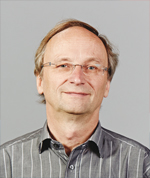Contact
Email:
soll@lmu.de
Endosymbiosis: from cyanobacteria to chloroplasts
Plastids are a diverse group of organelles found in all plants and algae. The most prominent plastid type is the chloroplast, as its main function is the conversion of light into chemical energy by photosynthesis. Chloroplasts derived from an endosymbiotic event, and most of the organelle genes were transferred to the host nucleus during evolution. Consequently, the vast majority of chloroplast proteins has to be posttranslationally targeted to and imported into the organelle. This translocation process is mediated by multiprotein machineries in the two chloroplast membranes: the Toc (translocon at the outer envelope of chloroplasts) and the Tic (translocon at the inner envelope of chloroplasts) complexes. Furthermore, the large biosynthetic capacity of chloroplasts requires not only protein import, but also a massive exchange of metabolites by transporters in the inner envelope or by selective ion channels in the outer envelope membrane. In our lab, several different model systems, including flowering plants (Arabidopsis thaliana, Pisum sativum), non-vascular plants (Physcomitrella patens) and cyanobacteria (Synechocystis) are established. We use a variety of biochemical and molecular biological methods to characterize the components and regulation mechanisms involved in the various protein or metabolite transport processes. In particular, we focus on (i) targeting of preproteins to and import into the chloroplast, (ii) regulation of protein import at the inner envelope and (iii) characterisation of solute channels in the outer membrane. For further information see http://www.en.botanik.bio.lmu.de/research/soll/index.html


